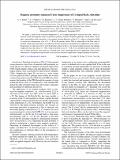Magnetic proximity-enhanced Curie temperature of Cr-doped Bi2Se3 thin films
Abstract
We report a study on the transition temperature TC of Cr-doped topological insulator thin films, where an increase in the ferromagnetic onset can provide a pathway towards low-power spintronics in the future. Arrott plots, measured by surface-sensitive x-ray magnetic circular dichroism at the Cr L2,3 edge as a function of field at various low temperatures, give a TC ≈ 7K for the pristine surface. This is comparable to the bulk value of the film, which means that there is no indication that the spontaneous magnetization is different near the surface. Evaporation of a thin layer of Co onto the pristine surface of the in-situ cleaved sample increases the ordering temperature near the surface to ∼19K, while in the bulk it rises to ∼10K. X-ray absorption spectroscopy shows that Cr enters the Bi2Se3 host matrix in a divalent state, and is unchanged by the Co deposition. These results demonstrate a straightforward procedure to increase the transition temperature of doped topological insulators.
Citation
Baker , A A , Figueroa , A I , Kummer , K , Collins-McIntyre , L J , Hesjedal , T & van der Laan , G 2015 , ' Magnetic proximity-enhanced Curie temperature of Cr-doped Bi 2 Se 3 thin films ' , Physical Review. B, Condensed matter and materials physics , vol. 92 , no. 9 , 094420 . https://doi.org/10.1103/PhysRevB.92.094420
Publication
Physical Review. B, Condensed matter and materials physics
Status
Peer reviewed
ISSN
1098-0121Type
Journal article
Description
Beam time awarded on ID32 at the ESRF (Proposal No. HC-1282) and on I10 at the Diamond Light Source (Proposal No. SI-10207) are acknowledged. T.H. acknowledges the John Fell Oxford University Press (OUP) Research Fund. A.A.B. was supported by Diamond Light Source and together with L.J.C.M. by EPSRC through Doctoral Training Awards.Collections
Items in the St Andrews Research Repository are protected by copyright, with all rights reserved, unless otherwise indicated.

